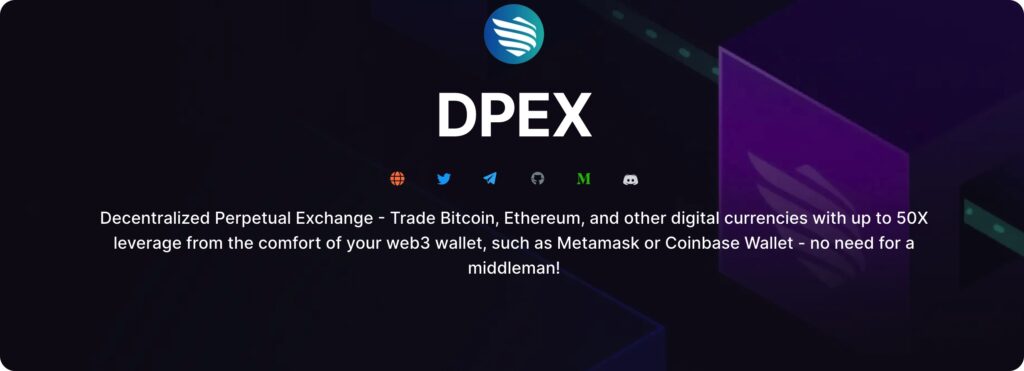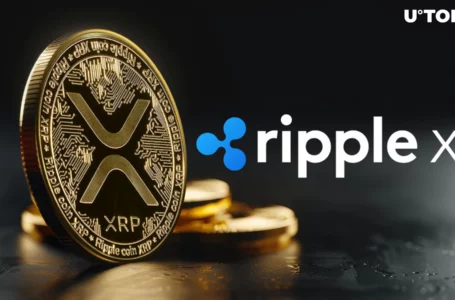
What is DPEX?
DPEX is a decentralized exchange platform on the Polygon network. Traders on DPEX enjoy low fees, zero-price impact trades and can access up to 50x leverage for both short and long trading positions.
The DEX makes use of multi-asset liquidity pools where liquidity providers can earn fees from swaps, market making, leveraged trading, spreads, funding fees, liquidations, and asset rebalancing. The price feed is highly efficient thanks to Chainlink oracles that offer dynamic pricing and TWAP pricing from leading decentralized exchanges.
DPEX places a strong emphasis on ensuring accurate price feeds to protect traders from malicious liquidation of their positions. Leveraging Chainlink oracles, DPEX ensures that the submitted prices are within a 2.5% range of the price, which is the only price feed used for liquidation calculations.
When it comes to obtaining price data, DPEX aggregates data from five centralized exchanges, including Binance, OKX, Kucoin, Bitfinex, and Gate.io. The median price of these exchanges is then used to submit the price on-chain until ChainLink is updated by the ChainLink foundation. This approach helps to ensure that DPEX’s price keeper is providing accurate and reliable price feeds to its users.
Decentralization is a Central Ethos of DPEX
For the true cypherpunk, you will be happy to know that DPEX stands for Decentralized Perpetual Exchange. Decentralization is a core priority behind the platform.
A red flag for me is any time a project has a large portion of equity allocated to the team or early investors. The DPEX foundation is founderless and memberless, governed by a DAO, with no equity being received by the team or investors. Satoshi himself would be proud.
The DPEX token is issued by DPEX Ltd, a special-purpose vehicle that oversees the issuance of the DPEX token. The team states that there has been a lot of legal work and planning to ensure the platform was created and remains as decentralized as possible.
CEXs vs. DEXs:
Centralized exchanges have long been the dominant player in the world of crypto trading. These exchanges are run by a single entity, which controls the exchange’s funds and user data. This centralized structure provides several benefits, such as faster transaction times, deeper liquidity, and a greater selection of trading pairs.
However, there are also significant drawbacks to centralized exchanges, such as vulnerability to hacks and security breaches. There have been several high-profile thefts of user funds, impacting the likes of Binance, Coinbase, KuCoin, dating back all the way to the infamous Mt. Gox hack. Many of the top exchanges have fallen victim to security breaches in recent years.
Additionally, centralized exchanges are subject to government regulation, which can limit their operations in certain jurisdictions and see users blocked from accessing their funds.
Decentralized exchanges, on the other hand, operate in a peer-to-peer (P2P) manner, with no central authority controlling the exchange’s funds or user data. This structure provides a high level of security, as there is no central point of failure that can be targeted by hackers or collapses that can happen as a result of company mismanagement.
Additionally, DEXs are not subject to government regulation or draconian boundary over-stepping restrictions that can result in users being blocked access to their crypto.
One of the most significant advantages of DEXs is their compatibility with DeFi and empowering users to retain control and custody over their assets without needing to trust a third party. DeFi refers to a set of financial applications that operate on blockchain technology and are designed to be decentralized.
However, DEXs also have some drawbacks. First, they tend to have slower transaction times and lower trading volumes than centralized exchanges. Additionally, the user experience can be more complicated, as users must interact directly with smart contracts as self-custodial wallets to execute trades.
The Shift to DEXs:
Despite the drawbacks of decentralized exchanges, there has been a significant shift towards DEXs in recent years, especially after crypto companies like FTX, Celsius, BlockFi, and others collapsed in 2022, highlighting the risks of centralized entities as customers lost access to millions worth of their crypto assets.
This shift has further been driven by other factors, including increasing concerns about security and privacy, the rise of decentralized finance (DeFi), and the emergence of new technologies that make DEXs more user-friendly.
Another factor driving the shift to DEXs is the emergence of new technologies, such as automated market makers (AMMs). AMMs are algorithms that use smart contracts to facilitate trades on DEXs. They have made it much easier for users to trade on DEXs, as they eliminate the need for order books and the complexities of price discovery.
Key Features of DPEX
DPEX offers a range of features that make it a solid choice among traders. Some of its key features include:
Decentralized Trading
DPEX operates on a decentralized platform, which means that it does not rely on a centralized entity to manage trades. This eliminates the need for intermediaries and offers users a higher level of security and privacy.
Multiple Trading Pairs
As far as asset support, DPEX supports trading for the following assets:
User-friendly Interface
DPEX has a simple and user-friendly interface that allows traders to navigate the platform easily and make trades quickly.
One of my favourite features of DPEX is the Tradingview integration for charting capabilities. Tradingview has become the industry gold standard for traders, thanks to its plethora of tools and features, the Tradingview integration makes DPEX suitable for even the most hardcore of technical analysts.
DPEX Security Measures
DPEX takes security seriously and has implemented several measures to ensure that traders’ funds are safe.
Here are some of the security measures that DPEX has put in place:
Regular Audits
DPEX conducts regular audits to ensure that its security measures are up-to-date and maintained. DPEX’s smart contracts are reviewed through audits conducted by CertiK for token security and Zokyo for platform security.
Self-Custody: A Cornerstone Of Security
Self-custody refers to the act of managing your own private keys rather than relying on a third-party custodian. This approach gives users complete control and responsibility over their cryptocurrency and reduces the risk of losing access to assets if the custodian is hacked or goes out of business.
To achieve self-custody, you’ll need to store your private keys in a secure location. This could be a hardware wallet, a paper wallet, or a software wallet with strong security features. It’s important to choose a wallet that’s compatible with your chosen cryptocurrency and to follow best practices for securing your private keys, such as storing them in a safe place and avoiding public Wi-Fi networks when accessing your wallet.
Self-custodial wallets such as Metamask, Coinbase Wallet, or other wallets via WalletConnect can be used to access the trading site. For the security-minded, cold storage hardware wallets like Ledger can be used via a Metamask connection to the DPEX decentralized exchange.
The ability to retain custody over your own funds is one of the reasons DEXs like DPEX are gaining in popularity, and for many, are a preferred way to trade versus using centralized platforms like Binance or Coinbase, where users give up ownership and rights over their assets.
DPEX Rewards
DPEX Rewards benefit long-term users of the protocol; these rewards come in Escrowed DPEX and Multiplier Points.
DPEX holders who choose to stake on the platform and DPLP holders (i.e., liquidity providers) receive rewards. These rewards can be in the form of tokens – Escrowed DPEX (esDPEX) and MATIC – and Multiplier Points. Here is a summary:
- Staked DPEX earns MATIC, esDPEX, and Multiplier Points.
- Staked esDPEX earns MATIC, esDPEX, and Multiplier Points.
- Multiplier Points: earns MATIC when staked DPLP held in the wallet earns MATIC and esDPEX.
Compounding or Claiming
There are two options for rewards on the Earn portion of the DEX. Users can either compound or claim their rewards. Compounding will stake a user’s pending Multiplier Points and Escrowed DPEX rewards, increasing the amount of rewards received.
Claiming will simply transfer any pending Escrowed DPEX and MATIC rewards to a user’s wallet. Compounded or Staked Escrowed DPEX tokens can be unstaked at any time.
Escrowed DPEX
Escrowed DPEX (esDPEX) can be used in two ways:
- Staked for rewards similar to regular DPEX tokens
- Vested to become actual DPEX tokens over one year
Vesting
You can convert your esDPEX tokens to DPEX tokens through vesting, which is accessible on the Earn page. When you initiate vesting, the average amount of DPEX or DPLP tokens used to earn your esDPEX rewards will be reserved.
Keep in mind that unstaked esDPEX tokens won’t earn rewards, but staked tokens will continue to earn rewards. After you initiate vesting, your esDPEX tokens will convert to DPEX every second and fully vest over a year. Once converted, you can claim your DPEX tokens at any time.
If you sell your DPEX or DPLP tokens and want to vest your esDPEX rewards later on, you’ll need to buy back the tokens. You can use DPEX, esDPEX, or Multiplier Points interchangeably for the required reserve amount.
You can deposit into the vesting vault while existing vesting is ongoing, but tokens reserved for vesting can’t be unstaked or sold. To unreserve your tokens, use the “Withdraw” button on the Earn page. Keep in mind that withdrawing will unreserve all tokens and pause vesting, as partial withdrawals aren’t supported. Finally, all esDPEX tokens that you vest into DPEX will remain as DPEX tokens.
Multiplier Points
Earn rewards for holding DPEX with Multiplier Points. Stake DPEX and receive Multiplier Points every second with a 100% fixed APR. Earn fee rewards by staking Multiplier Points through the “Compound” button on the Earn page. When you unstake DPEX or Escrowed DPEX tokens, a proportional amount of Multiplier Points will be burned. To transfer staked tokens without burning Multiplier Points, use the Transfer button on https://app.dpex.io/#/earn. The “Boost Percentage” on the Earn page shows the boost amount from your Multiplier Points, calculated by dividing your Multiplier Points by your total staked DPEX.
Pros and Cons of Using DPEX
Like any other cryptocurrency exchange, DPEX has its advantages and disadvantages. Here are some pros and cons of using DPEX:
Pros
- Decentralized trading, which offers users a higher level of security and privacy.
- Low transaction fees, making it an affordable option for traders.
- User-friendly interface that makes it easy for traders to navigate the platform.
- Tradingview integration makes DPEX suitable for all skill-levels of trader.
- Anonymity through the lack of user verification procedures.
- Audited smart contracts by Zokyo and CertiK for additional security.
- Fast transaction processing times
- Community-Driven: DPEX’s commitment to involving its community in decision-making processes, such as adding new assets through voting, fosters a sense of ownership and engagement among users.
Cons
- Limited trading options compared to centralized exchanges.
- Lack of customer support, which can be a problem for novice traders. DPEX does have an active community on Telegram and Discord provides some level of support that can still benefit beginner traders.
- The platform is still relatively new and has not been extensively tested.
- Faces competition from other DEXs and decentralized trading platforms.
In summary, DPEX is a promising DEX that offers traders a more secure and efficient way to trade digital assets, with a focus on perpetual trading options, fast transaction processing times, and low fees. Even though the platform is still new, it has undergone rigorous testing to ensure its reliability and security. But typically, new platforms undergo a process of improvement over time until they reach maturity.
Final Word
DPEX is a new and promising decentralized exchange platform that offers users a secure and efficient trading experience. Its low fees, options for leverage, perpetuals, and spot trading, along with robust charting and order type capabilities, make DPEX a fantastic trading platform alternative for anyone interested in DeFi.


















